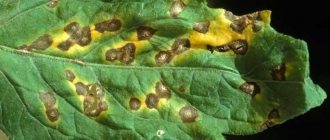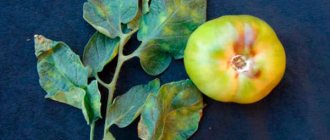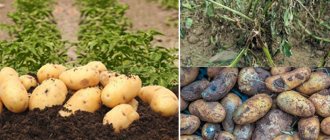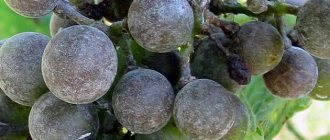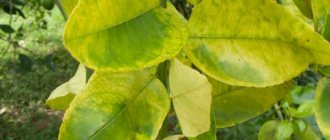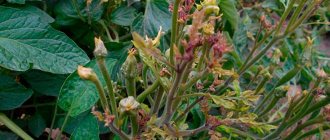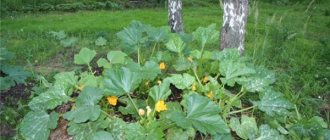In greenhouses and open ground, tomato bushes are often affected by diseases. Some of them carry pests, while others attack plants due to non-compliance with agricultural practices or the consequences of unfavorable weather.
Any of these reasons can have dire consequences for your crop. Therefore, it is so important to identify the disease in time and begin treatment. Of course, this is not so easy to do in the field, because many pathogens are perfectly camouflaged. But we hope that detailed descriptions and photographs will help you navigate.
Below we will look at the most common signs of fungal, viral, bacterial and some other diseases that can attack your beds. We will also present measures to combat them.
When using chemicals, remember that tomatoes can be eaten only 3-4 weeks after the last treatment.
Brown spots on leaves, stems and fruits of tomatoes
Brown necrosis with a light edge forms on the leaves and stems. A whitish coating is noticeable on the reverse side of the leaf blades in humid weather. The plant dries out. The inside of the fruits becomes covered with brown spots and rots.
Diagnosis: late blight of tomatoes is a fungal disease caused by microscopic fungi Phytophthora infestans.
The disease becomes more active in damp weather, and is especially dangerous in the second half of summer, when night temperatures become much lower than daytime readings. Fogs and dew also influence the development of the disease. At risk are tomatoes in open ground and film greenhouses without heating. After the leaves and stems are damaged, late blight spreads to the fruits and makes them unfit for consumption. If signs appear at the beginning of the growing season, complete loss of the crop is possible. The disease spreads very quickly, especially in humid weather.
Phytophthora also affects potatoes, eggplants, sweet peppers and other nightshades.
Control measures. To prevent the appearance of late blight, spray the plantings with Abiga-Peak, Consento, Revus or other fungicidal preparations. Repeat the treatment every 10 days. If the bushes are severely damaged, use Kuprolux or Famox fungicides. Just before ripening - biological products Fitosporin-M and Gamair. If the fruits begin to turn black, remove the remaining unripe tomatoes and place them in hot water (50°C) for a minute. Then dry and put in a box for ripening.
- Effective folk remedies for late blight on tomatoes and potatoes
The fight against late blight is not an easy task. How to protect tomatoes and potatoes from this disease?
Kinds
Tomato diseases are divided according to their origin into viral, bacterial, fungal and those that arise from poor quality care of plantings.
Late blight
Tomato leaves darken, fruits crack and rot. The disease is caused by a fungal infection . The hyphae of these organisms are almost always present in the soil and are difficult to remove from it. At the initial stage, the disease is difficult to diagnose. External signs appear when the mycelium has sufficiently grown into the internal tissues of the plant and root.
Alternaria blight
The second name is dry spotting. Most often appears on the green mass of the plant. The stem and leaves are covered with small but frequent gray spots. The yellowness gradually dissipates from the spots. In advanced cases, the fruits are also affected.
Fungal infection spreads through spores.
Anthracnose
Ulcerative lesions of leaves and fruits. They form deep rottenness in tomatoes, going all the way to the center of the vegetable. The fungus is well preserved in affected plant debris even after prolonged overheating in compost. Sick plants must be burned. Anthracnose also damages grapes.
Anthracnose on leaves and fruits
Septoria
External signs appear on tomato leaves. First, small specks of white or pale gray appear on them. As they grow, they cover the entire leaf. The development of the disease leads to complete drying of all leaves.
Manifestation of septoria
Gray rot
The fruits are covered with gray fluff from mushroom threads. Under the layer of mold, traces of gray rot with clearly defined black edges appear. Diagnosis can be made at the beginning of the disease, when the lower leaves of the plant begin to develop a rash and dry out.
Gray rot on tomatoes
White rot
External manifestations of the disease are the appearance of fluffy white mold on the fruit. The tissues located underneath rot and die. Damage by spores occurs when fruits are wounded.
White rot on tomatoes
Most often, the disease manifests itself during crop storage.
Powdery mildew
The fruits seem to be sprinkled with flour, rot and dry out. The disease often occurs in closed ground and glass greenhouses. On unprotected ground, the disease manifests itself extremely rarely. Powdery mildew is also common in cucumbers.
Manifestation of powdery mildew
If the disease is not treated, the rashes spread to the green mass, killing the entire plant.
Verticillium
Previously, this disease was the most common in tomatoes. Modern breeding has developed varieties that are resistant to damage . The disease is diagnosed by observing aging leaves. During the day they dry out a little. At night they are filled with moisture again and rise.
Tomato verticillium
Cladosporiosis
The second name of the disease is brown spot. All parts of the plant are covered with brown spots. Tomatoes growing in closed ground are affected by the disease, i.e. in greenhouses. The first signs of the disease are spots and drying of the lower leaves. The disease gradually spreads to the top of the plant.
To avoid this, you need to take into account all the requirements for autumn soil preparation for planting tomatoes in greenhouses.
Cladosporiosis of tomato leaves
Root rot
A disease that destroys the root system of tomato. As a result, the entire plant dies. At risk are plants growing in soils with high humidity, heavy soils that retain water for a long time . Under such conditions, the mycelium of the parasitic fungus grows rapidly, affecting neighboring plants.
Manifestation of tomato root rot
Stems cancer
The tomato stem begins to rot from the inside. There are no external manifestations of the disease until the damage reaches an irreversible stage. All conductive tissues of the stem are destroyed and cease to perform their functions.
Tomato stem cancer
Fusarium wilt
Gradual withering of the entire tomato bush. Plants that are not grown according to crop rotation rules are often affected. Plantings that grow year after year in the same place draw the necessary substances from the soil and weaken. Under such conditions, the influence of fungi increases.
Fusarium wilt of tomato
Southern late blight
Tomato fruits become covered with a rash and lose color. The tissues gradually begin to rot . Plants are affected during the seedling period and when the fruits begin to fill.
Manifestation of Southern late blight of tomato
The disease appears in closed ground with insufficient care of the plantings.
Bacterial mottling
The disease occurs rarely and does not cause serious harm to plants. A small brown rash appears on the leaves. If the disease is not treated, the spots grow, merge and lead to the death of the leaf .
Bacterial mottling of tomato leaves
Only the leaves of the tomato are affected. The fruits and stem are never damaged.
Bacterial cancer
The defeat of the plant provokes the destruction of internal tissues. Bacteria multiply in conductive fibers of stems, fruit pulp, and leaf petioles.
Manifestation of bacterial canker in tomato
Bacterial wilt
A disease, when diagnosed, all plantings must be destroyed. The tomato bush begins to fade uncontrollably. Nothing helps slow down this process. Moreover, there are no visible symptoms of any disease. Nightshade crops are affected by the causative agent of bacterial wilt.
Bacterial wilt of tomato
The highest risk in terms of incidence are regions with a tropical or subtropical climate.
Root cancer
Degeneration of tissues of the root system. Neoplasms do not have absorptive or conducting functions. They cover healthy tissues, disrupting their function. Plants are stunted. The growths themselves are similar in texture to pieces of wood. The disease is of bacterial origin, provoked by anaerobic bacilli.
Root cancer
Wet rot of fruits
Common names: black leg, watery rot. The bacteria enter into an alliance with the late blight pathogen, killing the plantings in a short period of time. A spot filled with liquid appears on the affected tomato. As the disease develops, the skin bursts and the fruit itself begins to rot. Within two days, the fruit completely rots from the inside and begins to stink. The pulp is liquid and black. As a rule, this is a classic answer to the question of why tomatoes rot.
Manifestation of wet rot of tomato
Necrosis of the stem core
The death of stem tissue invariably leads to the death of the plant. The first signs of damage appear during the formation of inflorescences . If emergency measures are not taken, the bush will completely wither before the fruits ripen. The internal tissues of the stem fill with liquid and begin to glaze. Next comes rotting due to stagnation of liquid.
Necrosis of the stem core
The first signs of stem necrosis are the appearance of oblong brown spots on the stem.
Black bacterial spot
High rates of damage from this disease are observed during rainy seasons. High humidity without the possibility of drying out the soil creates favorable conditions for the proliferation of harmful bacteria. All parts of the plant become covered with a small rash. The spots are watery and gradually darken. If young plants are affected, this can lead to their death.
Manifestation of black bacterial spot on tomato leaves
Aspermia
A disease leading to underdevelopment of fruits, leaves, and cessation of bush growth. The leaves become deformed and change color to pinkish. All green fabrics acquire a mosaic color with pale spots. It is impossible to get a harvest with such a disease. If a tomato is infected before flowering, it does not form seeds. And if after, then the fruits do not ripen. They are small, striped, with rotten places.
Aspermia of tomato leaves
Bronzing
Viral disease of tomatoes. Ring-shaped spots of pale color appear on leaves and fruits. Flowers and leaves fall off . The fruits begin to rot inside the spots. Systemic damage to the entire plant leads to a variety of symptoms: spots, mosaic coloring, rot, drying of the stem, necrosis of all tissues of the bush.
Bronzing of tomato
Yellow curl
A disease that initially affects leaves. They turn yellow and become deformed. Their edges begin to curl unevenly. The leaves of the upper part of the bush are the first to suffer . Then other parts of the plant are affected. The flowers fall off. The fruits set poorly or are severely delayed in development.
Manifestation of yellow curly tomato
Mosaic
A more common name is tobacco mosaic. A viral infection of a tomato causes the plant to wilt. The disease is characterized by a change in color of all parts of the bush. Spots of light and dark shades of green appear on them. Leaves become wrinkled.
The fruits lag behind in development and become smaller.
Hollowness of fruits
A disease that occurs on absolutely healthy soils and in conditions of complete protection from bacteria, viruses and fungi. Numerous cavities form inside the fruit. The tomato is small in size, its mass is small. In severe cases, the fruits completely lack seeds, and the tomatoes themselves lag behind in development and growth . The causes of this condition may be disturbances during fruit set, too high temperatures during growth, or a small amount of pollen during pollination.
Hollow fruits. unlike healthy ones, they form numerous cavities inside
Small spots on leaves, dark sunken spots on tomato fruits
Spots up to 1.5 cm in length are noticeable on the leaves and stems, sometimes with a black coating. Lesions most often form along the edges of the leaf. Then the spots increase in size and merge. The stems crack and the fruits become pitted with dark, dry spots.
Diagnosis : Alternaria blight, or dry spot, of tomatoes - a fungal disease.
Alternaria blight attacks plants immediately after planting tomato seedlings in open ground or a greenhouse. The fungus loves dry and hot weather, so it is especially dangerous for plants in glass greenhouses and film greenhouses. All parts of the bush are affected, and in the absence of treatment, yield losses amount to up to 85%. Fruits from infected bushes cannot be stored. The disease is easily transmitted to potatoes, and vice versa, so it is better not to plant them next to tomatoes.
Control measures . Spray the affected bushes with a 0.4-0.5% solution of Ordan. The following fungicides have also proven themselves in the fight against Alternaria: Profit Gold, Skor, OxyHOM, Proton. Carry out the treatment according to the instructions every 7-10 days until the signs of the disease disappear.
Useful tips
An effective method against many pathogens is treating the soil with copper sulfate, Fitolavin or a solution of potassium permanganate.
Another risk factor for disease is the proximity of plants. For example, potatoes are often infected with various diseases and also actively transmit them. In the same way, peppers and eggplants should not be planted next to tomatoes. It is also important to choose quality seeds and seedlings.
If you discover a disease and its source, do not overdo it with chemicals. We have learned from our own experience that it is better to sacrifice a couple of plants than to grow a crop full of chemicals. And we advise you to adhere to this rule.
Round brown spots with dark edging on tomato leaves
Small watery spots appear on old and then young leaves. At first they are not very noticeable, but then they turn white and become covered with a brown edging. The rest of the leaf turns yellow and dries out. The fruits are small and flaccid. Young leaves at the top of the bush are rarely affected.
agroflora.ru
Diagnosis : septoria, or white spot, of tomatoes - a fungal disease.
Most often, the disease affects plants in open ground. Foci of septoria can also occur in a greenhouse with high humidity. The fungus spreads from the lower leaves and base of the stem higher and higher, damaging young leaves, shoots and flowers. As a result, the bush is forced to spend energy on restoring green mass, and not on setting fruits and their ripening. Fungal spores quickly spread throughout the garden bed. High humidity, heat, and windy weather contribute to the reproduction and dispersion of the pathogen.
Control measures . At the initial stage of infection, it is important to remove the affected leaves so that the spores are not scattered with the wind to other plants. If the bush is completely affected by septoria, it is better to dig up the plant and burn it. Fungicides Abiga-Pik, Ordan, Profi, etc. are suitable for treating tomatoes. Spraying with copper sulfate (50-100 g per 10 liters of water) is also effective.
Tomato pests with descriptions and control methods
The immunity of tomatoes is not able to independently resist harmful insects; humans must take on the function of destroying parasites. Let's talk about the most dangerous and common pests of tomatoes and methods for their destruction.
Aphid
Insect colonies appear on plants in June-July. They can be found on the underside of the leaf. The parasites are very small in size, they can be yellowish or black.
Folk remedies used to combat aphids include a solution of soap and ash, an infusion of pungent and bitter plants (garlic, pepper, wormwood, yarrow, celandine, tobacco).
Suitable chemicals include Karbofos, Trichlorometaphos, and bleach. Spraying is done from the underside of the leaves.
Whitefly
A small whitish butterfly up to 3 mm in size. The pest itself causes damage to plants with its sticky secretions, which prevent the leaves from breathing and provoke the appearance of sooty fungus.
The most harmful ones are the offspring of whiteflies - translucent caterpillars. They can completely destroy plantings in 2-3 weeks. Affected bushes stop growing, ovaries, flowers and leaves fall off.
In the middle zone, the pest is more often found in greenhouses. In warm climates, whitefly infects open plantings. They fight the insect by spraying the bushes with Fitoverm and Aktara, trying to get on the lower part of the leaves.
Spider mite
The pest feeds on plant juices. It can be identified by the appearance of white and yellowish specks on the underside of the leaves. Later, white cobwebs appear on the tomatoes. Folk remedies to combat ticks include spraying with alcohol and soap solution, tincture of dandelion, tobacco and garlic. Among industrial preparations, Karbofos, Agravertin, and Antiklesch are suitable.
Stink bugs
Pests move onto tomatoes during the fruiting period from weeds growing nearby. Traces of their presence can be found in the form of light spots on the skin of the fruit. To kill bedbugs, insecticides such as Atkara, Karbofos, Phosfamide, and Chlorophos are used.
Colorado beetle
Due to its bright striped color, the pest is clearly visible on tomato leaves. The beetles lay brownish eggs on the lower part of the leaf blade, from which larvae soon emerge and completely eat the bush. An overwintered pest poses the greatest danger in the spring.
Until the potatoes grow tops, the beetles feed on tomato seedlings planted in the ground. Repeated treatments with drugs: “Mospilan”, “Prestige”, “Aktara”, “Iskra” will help to destroy pests. You can repel beetle larvae by spraying tomatoes with an ash-soap solution. Pests are also collected by hand.
Medvedka
The insect's body can be up to 5 cm long. It lives everywhere. The pest likes loose, warm soil, so it can often be found in greenhouses. The mole cricket digs numerous holes in the ground, as a result of which the root system of tomatoes suffers and the plants may die.
To repel pests, pour pine needles into the hole when planting and drip iodine. Some people put peeled garlic cloves and pieces of fish in the ground.
Among the chemicals that are effective in the fight against mole crickets are the following drugs: “Medvetox”, “Grom”, “Grizzly” - they are produced in the form of granules that are eaten by insects.
Root-knot nematodes, wireworms, and gnawing cutworms are also often found .
On a note! In order to repel pests, it is recommended to plant plants next to tomatoes that produce essential oils - marigolds, calendula, nasturtium, legumes.
Spider mites on tomatoes: video
Yellowish spots on tomato leaves
First, the lower leaves become stained, then the disease spreads to the entire plant. The leaves dry out, curl and fall off, and hard olive-colored spots are visible on the fruits.
sazhaemvsadu.ru
Diagnosis : cladosporiosis, or brown spot, of tomatoes - a fungal disease.
The development of the disease is facilitated by growing in unheated and rarely ventilated greenhouses. Leaves are most often affected. Fruits, stems and ovaries are less likely to suffer. But since the plants lose their leaves, the harvest is very poor. And if the disease spreads to the fruits, they shrink and dry out.
Control measures . Treat the first lesions with Abiga-Peak, Sporobacterin or Pseudobacterin-2. During the summer, spray the bushes with a 0.05% solution of Fitosporin-M. For prevention, regularly remove old leaves and maintain the humidity in the greenhouse no higher than 80%.
Cladosporiosis or brown spot of tomatoes, treatment
Cladosporiosis of tomatoes, photo
Brown olive spot (cladosporiosis) is also a fungal disease, but it mainly spreads in the greenhouse. The lower leaves become diseased first. Chlorotic yellow round spots appear on the upper side of the leaf, which will subsequently merge and look like one single spot. The underside of the leaf is covered with a brown velvety coating - these are fungal spores. As a result, the leaves gradually begin to curl and dry out. More often the disease manifests itself during flowering or at the beginning of fruiting. The earlier the infection occurs, the more harmful it is. With high air humidity (up to 95%), daylight hours of about 10-12 hours and low illumination, the disease is more acute.
In the pictures above you will see the manifestation of the disease in the process of development - from the moment the first signs appear until the peak of the disease (if you look at the photo from top to bottom).
Fetuses are rarely affected by this disease, mainly only if no measures are taken. If this happens, then the fruits become brownish-dark, soften - then they will dry out anyway. The cause of the disease may be watering with too cold water, a sharp temperature change, or dampness. Before treatment, all affected leaves are broken off.
Control measures are copper-containing preparations, for example, Bordeaux mixture or Barrier, Barrier.
White coating on tomato leaves
The leaves on both sides are covered with a white coating. Round spots are located throughout the leaf blade, then merge and darken.
mislife.ru
Diagnosis : tomato powdery mildew is a fungal disease.
The development of the disease is facilitated by excess nitrogen fertilizers and errors in irrigation. Powdery mildew does not cause much damage to open ground tomatoes, but greenhouse tomatoes have a hard time. Photosynthesis processes are disrupted and leaves gradually die. With severe damage, the stems and peduncles turn white. The fungus weakens plant immunity and significantly reduces yield. If measures are not taken, the bush may die entirely. Many summer residents mistake the white coating for dust, but in fact it is the mycelium of the fungus, which grows very quickly and is transferred to other plants. It can also coat fruits, impairing their taste.
Control measures . When the first signs appear, treat the tomatoes with fungicides: Pseudobacterin-2, Sporobacterin, Topaz, Provisor, etc. For prevention, spray the beds with a 0.5% Baktofit solution. After two weeks, repeat the procedure. Carry out the third treatment 7-10 after the second.
Dark sunken spots on tomato fruits
The fruits are covered with softened spots up to 1 cm in diameter. At first they are hardly noticeable and do not differ from the color of the skin. Then they darken and turn black. The fruits are completely mummified. Brown flaky spots are visible on the roots.
seminis.ru
Diagnosis : tomato anthracnose is a fungal disease.
Anthracnose is widely found both in open ground and in greenhouses. More often, mature bushes suffer from it. The peak of the disease occurs in late summer and early autumn. Mainly fruits, roots and root collars are affected. Ripe tomatoes cannot be eaten; they are watery and tasteless. The spots darken over time, and fungal spores become visible on them. Anthracnose often appears on bushes together with Alternaria, causing a mixed infection.
Control measures . Remove the affected fruits and spray the bushes with copper oxychloride (40 g per bucket of water) or 1% Bordeaux mixture. The latter can also be used to prevent disease. To do this, spray the plantings 3-4 times every 10-12 days. When the greenhouse is empty, completely disinfect it with bleach (200 g per 10 liters of water).
Necrotic spots on leaves and stems, white spots on tomato fruits
The stalks and petioles become covered with ulcers, the stems crack, and mucus is released from them. The leaves dry out and curl on one side, but do not fall off. The fruits are speckled with small hard spots. The plant is withering.
Diagnosis : bacterial canker of tomatoes is a disease caused by non-spore-bearing aerobic bacteria.
Cancer most often affects greenhouse tomatoes growing in conditions of high humidity and insufficient lighting. High temperature and waterlogged soil also influence the development of the disease. Crop losses can reach 30%.
Control measures . Affected plants cannot be treated. Dig them up and burn them. Treat the remaining tomatoes with 1% Bordeaux mixture to prevent infection. For prevention, use Fitosporin-M, Gamair, Fitolavin.
Black bacterial spot
The disease develops at high humidity and temperatures within +15-22 degrees. The causative agent is the aerobic gram-negative bacillus Dowson. Bacterial spotting progresses during periods of intensive fruit growth. The bacterium can survive on seeds and weeds. It penetrates into the plant through microscopic wounds.
Symptoms
The disease manifests itself locally on stems, leaves, and petioles. It can be recognized by watery, shapeless spots 2-3 mm in size. They have a narrow chlorotic halo. Sometimes the spots merge into a single whole and spread to the veins. With severe damage, the leaves suddenly turn yellow and fall off.
As the disease progresses, it spreads to green fruits in the form of dark spots, which are bordered by a watery halo. Subsequently, they increase in size and become depressed. As a result, the skin of the fruit in the affected area cracks along the periphery and the spots turn into scabs. Around them, the tissues become watery with deep rot.
Treatment and prevention
Bacterial black spot is easier to prevent than to treat later. To do this, it is necessary to observe crop rotation, disinfect seeds at a temperature of +52-53 degrees and purchase varieties that have increased resistance to bacteria.
The disease cannot be treated, but its development can be slowed down and the negative impact of the bacteria on tomatoes can be reduced if the bushes are treated weekly with a 1% solution of copper sulfate or Bordeaux mixture.
Tomato leaves are curled, yellowish in color, and have a white coating on the roots.
The lower leaves quickly die and the petioles become deformed. The tops of the bushes become limp. The vessels in the stems turn brown, metabolism is disrupted and the plant withers.
koppertus.com
Diagnosis : fusarium wilt of tomatoes - a fungal disease.
The disease is very dangerous because The fungus that causes fusarium is resistant to many chemicals. This makes diagnosis difficult. Many people confuse the disease with non-infectious chlorosis, which occurs from improper watering and fertilizing, or verticillium, which is also characterized by wilting. Meanwhile, it is the pronounced chlorosis in this case that excludes the disease with verticillium and, together with the signs described above, indicates the infectious origin of the disease.
Control measures . Treat the affected plants with working solutions of drugs: Bacterra, Fitosporin-M, Alirin-B or others. By the way, they can also be used to treat seeds before sowing. For prevention, after planting in the ground, water the tomatoes with Pseudobacterin-2.
Treatment methods
It is impossible to cure bacterial wilt of tomatoes. Moreover, conventional fungicides will help little here - they are designed to destroy fungal infections.
If a gardener claims to have cured potatoes or tomatoes with copper-containing preparations or other means of similar action, most likely the disease was misdiagnosed. Or it was in the initial stage, and fungicides simply stopped the development of bacteriosis until harvest.
Antibacterial drugs, such as Fitolavin, rather contain the infection and prevent it from spreading, rather than treat it. This is an antibiotic fungicide that penetrates and moves through tomato tissues. It reduces the activity of bacteria, displaces them, but does not completely destroy them. You need to cultivate the bush and the ground.
In the treatment of tomatoes, drugs intended for humans are also used - nitrofurans. The cheapest but most effective is Furazolidone. For treatment, 150 mg of the active substance (3 tablets of 50 mg each) are dissolved in a liter of water.
But nitrofurans are not able to penetrate into the tissues of tomatoes and other plants. Watering the soil and surface treatment are not effective enough. To correct the situation, add 2 teaspoons of Dimexide per liter of solution. It enhances the penetration of other drugs into the cells of living organisms.
At the same time, the effectiveness of nitrofurans, including Furazolidone, increases 20 (!) times. The action of Fitolavin and other antibiotic fungicides is also significantly improved. The waiting period after processing is a week. Then the tomatoes can be collected and eaten.
Unfortunately, we cannot stop there. Along with pathogenic bacteria, nitrofurans also destroy beneficial ones, without which plants remain defenseless against a new attack by microorganisms.
After a week, the tomatoes should be treated with one of the following preparations:
- Bactogen;
- Gulliver;
- Stimulus;
- Fitosporin.
They will populate the plant and soil with beneficial bacteria, which will not give pathogens a chance to penetrate the soil or cells of the nightshade plant.
The lower leaves of tomatoes dry out and fall off, the upper leaves curl
The leaves partially turn yellow, then necrotic spots appear on them, and the roots gradually die.
kccc.ru
Diagnosis : verticillium wilt, or verticillium wilt, of tomatoes - a fungal disease.
Until recently, verticillium was one of the most dangerous and widespread diseases of tomatoes. But today, many varieties and hybrids that are resistant to it have been bred, so infection occurs less and less often. Meanwhile, the fungus that causes wilting still lives in the soil and, under favorable conditions (low temperature and high humidity), infects plants. Young tomato bushes that have just begun to grow are especially affected.
Control measures . For treatment, use the drugs Previkur Energy, Trichocin, Trichoderma Veride. After picking, when the plants take root, feed them with the following mixture: 2 g of copper and zinc sulfate, 3 g of boric acid and 10 g of potassium permanganate per bucket of water. After 10 days, repeat the procedure. Carry out the third feeding after 20 days, and after another 30 days - the fourth. This will strengthen the immunity of tomatoes.
Watery spots on leaves, stems and fruits of tomatoes
The affected areas increase in size, then sporulation of the fungus in the form of brown dots becomes noticeable on them. The leaves turn yellow due to metabolic disorders. The plant withers and dies.
Diagnosis : gray rot of tomatoes is a fungal disease.
The fungus becomes active during the fruiting period in humid weather. The first signs of damage can be seen on the leaves. Small gray dots quickly become large, merge and become covered with plaque. The disease is especially dangerous for greenhouse tomatoes that grow in conditions of high humidity.
Control measures . If there are few lesions, immediately treat the plantings with this composition: add 1 cup of ash and 1 tsp to 10 liters of water. copper sulfate. The mixture is enough for 2-3 sq.m. If the disease is severe, spray the leaves and stems of tomatoes with Fitosporin-M, Sporobacterin, Bacterra, Trichocin or a 1% solution of Bordeaux mixture.
Fungal diseases
Fungal diseases are characterized by increased resistance. In my more than ten years of gardening experience, I can say that it was these diseases that took a lot of effort and time. It is best to fight fungi constantly, as they tolerate both high and low temperatures well. They can live and reproduce in the soil for years, attacking plants with renewed vigor each season.
Cladosporiosis
As it develops, brown spots and a gray coating appear on the foliage.
The disease does not spread to stems and fruits, but actively affects the green mass. Easily transmitted from one plant to another. If you miss the moment of infection of one plant, then very soon the disease will cover the entire batch of seedlings. If the disease is detected in the early stages, there is a chance to save the seedlings. But pathogens can remain alive for up to 10 months.
To protect other plants, it is necessary to remove the diseased bush from the greenhouse.
Treatment:
- The folk method recommends diluting 1 liter of whey in 10 liters of water and spraying the plants.
- After this, it is necessary to disinfect the soil: 30 g of potassium chloride is dissolved in 10 liters of water and with the addition of 40 drops of iodine.
- A decoction of wood ash is also effective: a water infusion of 300 g. ash is dissolved in 10 liters of water and used for irrigation.
Abiga-PIK
Bravo
HOM
- Chemical treatment of cladosporiosis requires the use of broad-spectrum fungicides: Abiga-PIK, Bravo, Polyram, HOM, etc. Dosages are indicated in the instructions for the product. Plants should be processed late in the evening, in dry weather. Treatment should be repeated once every 10 days.
Late blight
As this disease develops, the leaves will first darken, then the fruits. New ovaries do not appear, since the affected green mass will very soon turn yellow and fall off. On fruits, the disease first appears as black spots, then they increase in size until they completely cover the surface.
Treatment:
Treatment with folk remedies involves the use of 1 liter of whey or kefir. They should be diluted with 10 liters of water and sprayed on plants for treatment and prevention purposes.- A solution of table salt with water has a positive effect against late blight. It should be diluted 300 gr. table salt in 10 liters of water.
- Another homemade solution is made from a solution of 2 tablespoons of baking soda, 50 g. liquid soap and 10 liters of water.
- With the chemical control method, late blight is treated with ordinary Furacilin - 10 tablets per 1 liter of water.
Anthracnose
If brown spots appear on the tomatoes, as if “pressed” on the surface, then this is anthrocnose.
The site area has a yellow line. The spot will darken and turn purple in a few days. If the infection spreads to the bushes, the entire bush becomes covered with disease. Affected bushes stop growing.
Expert opinion
Kopylov Timofey Igorevich
An amateur gardener with a huge amount of life experience
Over time, the affected bushes dry out. Anthracnose affects those fruits that grow close to the ground and directly touch it. To prevent further spread of the disease, I usually take the affected bush and dig it away from the greenhouse. I carefully subject the remaining plants to preventive measures.
Treatment recipes
- Anthracnose is effectively eliminated with a 1% solution of Bordeaux mixture. Another recipe: 40 gr. Copper oxychloride is dissolved in 10 liters of water and sprayed on the plants. This method is suitable for those who prefer traditional recipes.
- Chemical agents against anthracnose: “Gamair”, “Fitosporin-M”, “Cumulus DF”, “Polyrama”, etc. But it is worth remembering that the fungus adapts to poisons (anthracnose is a fungal disease), so the products must be alternated.
Gamair
Fitosporin-M
Cumulus DF
Light speckled spots and wrinkled areas on tomato leaves
The leaves are mottled in color, then become deformed and take on a thread-like shape. Leaf-like outgrowths appear on the lower part. The plant slows down in growth, cannot set fruit and soon dies.
gardenaddict.ru
Diagnosis : tomato mosaic is a viral disease.
Mosaic causes enormous damage to tomatoes in open ground and greenhouses. Plants pick up the virus during an invasion of aphids, nematodes and thrips, which carry this disease, as well as when tissues are damaged by dirty garden tools. If a bush is infected at the beginning of development, its fruits will grow defective and unsuitable for food. Possible loss of half the harvest.
Control measures . Infected plants cannot be treated. To stop the spread of infection, dig them up and burn them. Treat the soil with Indigo, Bordeaux mixture or other fungicides. You can spray lightly affected bushes with a whey solution (100 ml per 1 liter of water) with the addition of Farmayod. For prevention, before sowing, treat the seeds in a 1% solution of potassium permanganate.
Tomato stem necrosis
Viral disease. The first signs of the disease appear on the stems of well-developed plants, when the first bunches of fruit begin to form. Small cracks appear at the bottom of the stem, initially dark green in color. Then, in these cracks, the rudiments of aerial roots appear. The leaves begin to wither, the plant falls, the bush dies. The fruits do not have time to ripen.
The source of infection is seeds, contaminated soil. Such bushes must be torn out, destroyed - burned or buried. Treat the soil with a 0.2% solution of Fitolavin-300.
Watery dark spots on the bottom of tomato fruits
First, barely noticeable watery spots appear at the base of the fruit (usually green or just beginning to ripen), which soon increase in size and acquire a brown tint. The fruits become dark by a third, wrinkle and turn black.
youtube.com
Diagnosis : tomato blossom end rot is a physiological disease associated with violations of agricultural practices and genetic characteristics of plants.
The disease usually occurs due to improper watering or excessive foliage of plants. Rot is also caused by unbalanced feeding and the development of fruits, when nutrients (in particular calcium) do not have time to get to the top. This is especially true for large-fruited tomato varieties. Temperature changes can also affect the appearance of watery spots. Tomatoes are affected in greenhouses and open ground. Bushes weakened by disease bear fruit poorly. Rotting fruits harm plant immunity. As a result, up to 50-60% of the expected harvest may be lost.
Control measures . When the first signs appear, remove rotten fruits from the bushes and spray the leaves with a 0.2% solution of calcium chloride. Repeat the treatment two more times during the week. For prevention, treat the leaves and soil with a solution of calcium nitrate (1 tablespoon per 10 liters of water). Among the drugs you can use Fitosporin-M, Gamair, Alirin-B. Do not apply too much nitrogen fertilizer, and avoid applying fresh manure. During autumn digging, enrich the soil with calcium.
Symptoms in greenhouses and open ground
The main external sign of damage to tomatoes by the bacterium Ralstonia solanacearum is wilting of the leaves, which is clearly visible in the photo. Some sources claim that it begins from the lower part of the plant, others indicate that the top and young vegetative organs are the first to lose turgor.
There is no contradiction in the description. If the disease develops rapidly, the tender upper leaves fade first, while the lower ones last longer. This is how the disease most often manifests itself in greenhouses and greenhouses.
When external conditions are not very conducive to the spread of the bacterium, the infection develops over about 2 months, moving from the roots upward. Then the lower leaves of the tomatoes are the first to lose turgor and droop. This is more typical for open ground.
Other signs of bacterial wilt:
- the leaves remain green, whereas with fungal infections they change color;
- in chronic cases, brown stripes appear on the stems running from bottom to top;
- a mass of adventitious roots appears, and they are located throughout the shoot, and not just in places of contact with the ground, and are in their infancy;
- when damaged, stems release a cloudy, viscous liquid;
- diseased tissue on tomato fruits thickens and turns brownish;
- If you cut a tomato stem, in the initial stages of the disease the inside will be yellow-brown, then cracks and voids appear, and before the plant dies, the color of the core changes to dark.
To make sure that the tomatoes are actually affected by bacteria, separate the shoot and place it in clean water. If a whitish or creamy liquid oozes from the wound surface, the last doubts should disappear.
White and yellow stripes on tomato fruits, purple leaves and stems
The fruits are woody and tasteless, covered inside with a white network of vessels. The leaves are curled, have an unnatural color, and become smaller over time. Stamens and pistils in flowers are underdeveloped. The roots are covered with cracks. The plant is stunted in growth.
Diagnosis : mycoplasmosis, or stolbur, of tomatoes is an infectious disease caused by mycoplasmas, tiny bacteria that live in the vessels of plants.
Stolbur most often affects plants in open ground. The peak of the disease usually occurs at the end of August. The disease is carried by sucking insects, in particular the leafhopper (slobbering frog), a dangerous garden pest. The risk of infection with stolbur increases in hot and dry weather, when insects actively reproduce. The infection can also enter the soil through infected seeds and seedlings.
Control measures . Infected bushes need to be dug up, because... they cannot be treated. To prevent re-infestation, weeds must be controlled. You can also spray plantings against leafhoppers with Kinmiks or Aktara. Dusting plants with wood ash (30 g per bush) will also help.
Prevention of tomato diseases
Timely preventive measures will help you protect plants from pathogens:
- plant disease-resistant tomato varieties;
- before sowing seeds for seedlings, treat them in a solution of Fitolavin or Maxim Dachnik;
- disinfect garden tools;
- disinfect the soil using Trichoderma Veride, Trichocin, Fitosporin-M and other biological products; a solution of potassium permanganate is also suitable;
- discard weak and diseased plants;
- observe crop rotation;
- increase plant immunity with a double dose of potassium fertilizers;
- follow the watering and fertilizing regime;
- regulate the temperature and humidity in the greenhouse (the norm is no higher than 32°C and 80%);
- destroy pests and weed;
- Clean the greenhouse at the end of the season, remove plant debris and dig up the soil.
To ensure that the tomato harvest increases every year, monitor the health of the plants and take timely measures to combat major diseases. Also read about how to identify and treat diseases of cucumbers, peppers and zucchini.
Features of tomato diseases
Plant development is influenced by growing conditions. In an artificial climate, crops develop differently than in open ground. Therefore, diseases will manifest themselves differently.
In the greenhouse
Cultivation buildings are characterized by higher humidity and air temperature than outside. When creating acceptable conditions for growing tomatoes, one should not forget that this climate is also suitable for the active reproduction of bacteria.
In greenhouses, the migration of fungal spores and viruses from bush to bush occurs faster than in open beds.
It is also comfortable for pests, which are the main carriers of diseases, to exist in such conditions.
The following factors lead to the emergence and spread of diseases in closed spaces:
- using cold water for irrigation;
- prolonged waterlogging or overdrying of the soil;
- air humidity inappropriate for this crop;
- applying dry fertilizers to the bushes;
- overfeeding with nitrogen preparations;
- poor ventilation of buildings.
The spread of fungal diseases is also facilitated by a faulty roof on which moisture accumulates. Cold droplets falling on tomato leaves increases the likelihood of damage.
It is also necessary to take into account humidity and temperature indicators that create risky conditions for the development of certain diseases:
- fusarium - begins to appear at 25-28 degrees Celsius against the background of low soil moisture;
- verticillium - bushes wither at 16-20 degrees and dry soil;
- black leg - manifests itself if, for 2 weeks in waterlogged soil, the soil temperature is kept below 18 degrees, and the air temperature below 16;
- gray rot - plants are affected by the disease if, in cloudy cold weather, the temperature outside the window in the greenhouse is maintained no higher than 16-18 degrees Celsius;
- powdery mildew - will develop if the humidity in the room is above 85% and the air temperature is below 20 degrees;
- late blight - it is also facilitated by low temperatures (14-23 degrees) with a humidity of more than 75%.
From this list we can conclude that it is important to maintain optimal all operating parameters in cultivated structures in order to protect the garden from infection by fungi, viruses and bacteria.
In the open ground
If it is possible to maintain the necessary conditions for growing tomatoes in a greenhouse, then in open beds you have to rely only on favorable weather.
Therefore, the main agrotechnical measures are aimed at:
- for watering;
- timely feeding;
- pest and weed control.
In open beds, some greenhouse diseases hardly appear (for example, cladosporiosis or black rot). But mosaic and powdery mildew are frequent “guests” of vegetable gardens.
In addition, the condition of plants is influenced by sudden temperature changes (day - night), sunlight (probability of burns), strong winds, and rainy summers.
